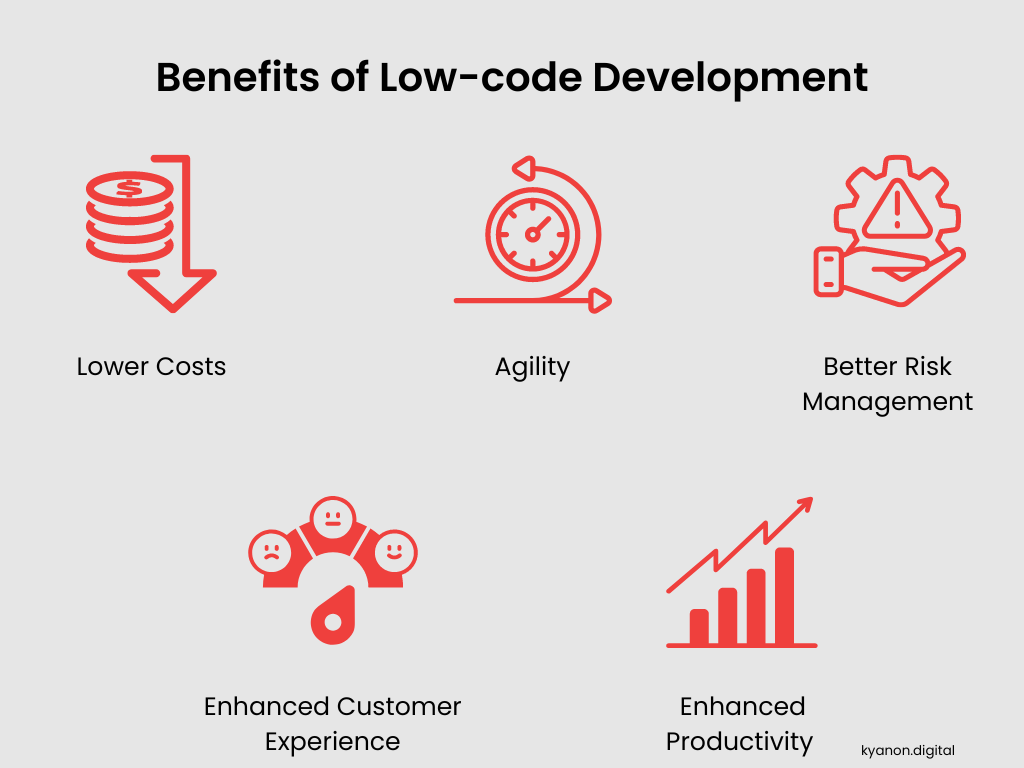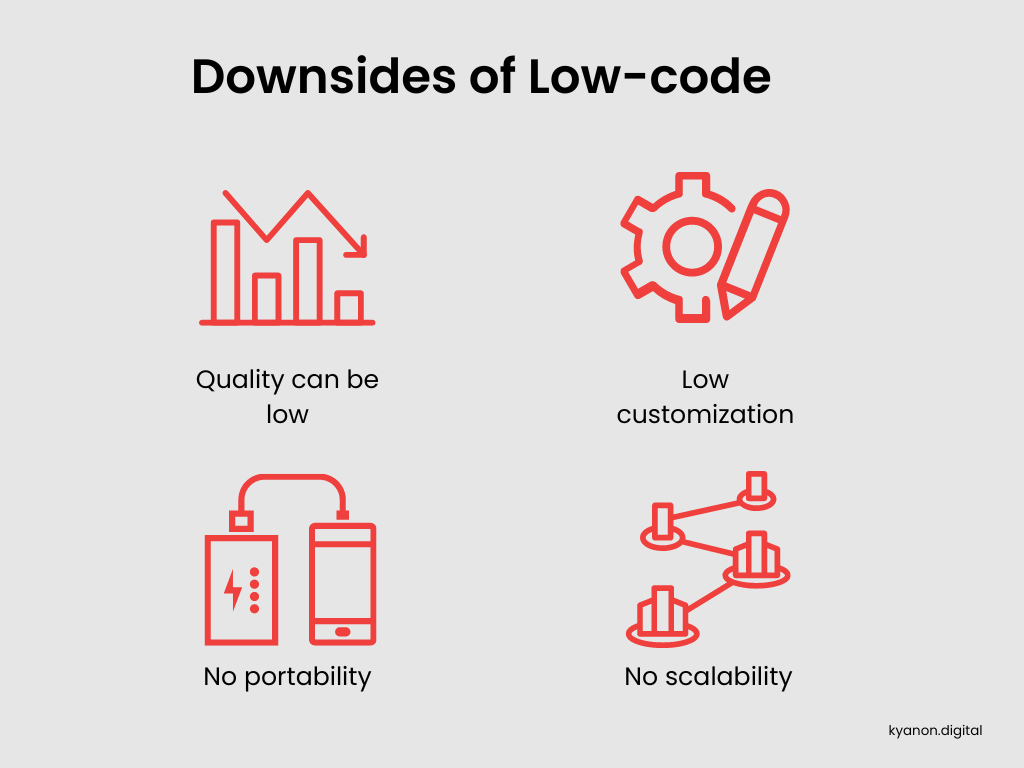Businesses of all sizes are introducing their own apps to grow their customer bases and their revenue. In the past, traditional (or custom) software development was the only way for businesses to do this. However, low-code has become an important ingredient in enabling businesses to adapt to their changing environments quickly, since it can be used as a supplementary force for traditional development in the IT industry. Then, which would be the most suitable digital transformation for your business? Let’s Kyanon Digital address the debate between low-code vs. traditional development.
1. Definition
1.1. Low-code
According to Mendix, low-code is a visual approach to software development that optimizes the entire development process to accelerate delivery. With low-code, you can abstract and automate every step of the application lifecycle to streamline the deployment of a variety of solutions. By breaking down traditional silos of business and IT (promoting continuous collaboration), your organization can develop solutions that meet the needs of your business.
1.2 Traditional coding
Traditional development is developing software applications using manual coding, which refers to working with an entire team of developers and programmers to gather specific requirements, develop a plan, and work with a development team to create custom code for an application to meet the specified needs.
2. Low-code vs. Traditional Development
2.1. Coding Knowledge
- Minimum knowledge is required, so low-code developers will only need to gain basic coding understanding.
- Professional web developers with advanced coding skills and knowledge of multiple web frameworks work with traditional web apps.
2.2. Speed of Development
- Low-code development platforms (LCDP) are known for their rapid development. You can develop a working web app in just 1-3 weeks.
- Traditional development requires hardcore coding and may take 2-8 months to complete. This is because of extensive coding, multiple prototype revisions, and testing and bug fixes.
2.3. Customization
- With LCDP platforms you may have limited customization to your web app.
- With traditional coding, the web app can be tailored to meet your specific requirements.
2.4. Agility
- Low-code apps are more agile because you can make changes quickly. Your new app releases will be quicker and any errors can be backtracked and resolved immediately.
- With traditional custom development, changes can be slow.
2.5. Deployment
- Deploying low-code apps is fast. But you have access to limited platforms. Depending on the low-code tools you are using, you can deploy only to supported platforms.
- With traditional web apps, you are free to deploy to any and all platforms.
2.6. Maintenance
- Low-code apps are easy to maintain comparatively. When the company updates the low-code platform, your low-code web apps will be automatically updated. So you spend minimal resources in the regular maintenance.
- Custom-built web apps can be tough to regularly update and maintain. You need a dedicated team to update the code each time.
Transform your ideas into reality with our services. Get started today!
Our team will contact you within 24 hours.
3. Benefits of low-code development

3.1. Lower Costs
With low-code development services, the time and costs get decreased substantially, and enterprises need not hire as many developers.
Additionally, when you choose low-code development for your product, you enjoy the flexibility that the Agile method provides as these platforms support versioning for any edits that were made to the application.
3.2. Agility
Low-code development allows organizations to develop and make changes faster. The skills that are necessary to create low-code development products are much less as compared to custom development because they provide configuration-based design experiences.
3.3. Better Risk management
With constantly changing regulations, enterprises can make adjustments quickly in case of a low-code approach to stay compliant.
Further, all of the configuration processes in this case, including code writing, compiling, and debugging, are much faster compared to traditional development methods.
3.4. Enhanced Customer Experience
Low-code platforms automate multiple operations that are crucial to customer experience. The agility in app development and strong business process features help in building much better apps, thus improving the overall customer experience.
3.5. Enhanced Productivity
Low-cod platforms help bridge the gap between IT and business teams, allowing them to solve real issues that impact the company.
Using this approach, business teams can create their own applications without having to wait for developers. It eliminates the need for complex code that increases access to more team members, leading to enhanced productivity.
4. Downsides of low-code development

4.1. Quality can be low
When you use pre-written modules, sometimes it can affect the quality of your app.
4.2. Low customization
Customization is something you have to sacrifice if you use a low-code platform. Even if some platforms provide customization to an extent, you need technical proficiency to add personalization.
4.3. No portability
Deployment options are very limited when using a low-code platform. In addition, if you want to change the platform for some reason, code migration is almost impossible.
4.4. No scalability
Low-code applications are not suitable for a large audience. If you want to scale it to enterprise solutions, low-code platforms are not an appropriate choice.
5. Advantages of traditional development

5.1. High scalability
With the traditional approach of web development, you have the freedom to scale the app as you require. Since all the code is written from scratch, you can make the code scalable and portable from day one.
5.2. Completely customizable
With experienced software engineers in your team, you have the ability to get complete personalization. Whatever feature or functionality you require can be added.
5.3. Highest quality ensured
In the traditional development approach, you have the freedom to ask for re-coding if something is not up-to-the-mark. With professional developers who work dedicatedly on your project for months on end, quality is ensured.
5.4. Custom UI/UX design
With the traditional web apps, you can design a unique and personalized UI/UX that makes your app stand out.
6. Disadvantages of traditional development

6.1. Time
Manual programming is more time-consuming than auto-generated code from low-code tools. It also takes longer to manually tweak code to support multiple platforms, and build sockets and other interfaces between applications and services.
6.2. Skills
Traditional development may require more specialized expertise with a certain programming language or development platform. Still, low-code development also requires special skills.
6.3. Cost
The cost of developing custom web applications and websites is high. You need to invest more time and resources for a longer period of time to get a highly effective web app.
7. When to go for low-code development?

7.1. Integrations
Low-code tools can make it easier to integrate an app that you build with external tools or platforms.
7.2. Business analytics
A low-code approach is often ideal to build dashboards or reporting tools to support business analytics — in fact, many ERP and business process management (BPM) platforms offer integrated low-code tools.
7.3. Business processes
Similarly, apps that support simple business processes such as customer data collection or vendor contract approvals are good candidates for low-code development. Low-code integrations in BPM platforms make these apps easy to build even for people who aren’t professional coders.
7.4 Omni-channel integrations of standardized solutions
Banks, financial services companies, insurance businesses, and call centers are the main users of low-code platforms. Low-code platforms accelerate the development and launch of software to quickly fetch data from multiple data sources, process it, and display it on web and mobile dashboards.
7.5 Microservices-based apps
With low-code development platforms, enterprises like Amazon and Netflix create numerous micro apps that can integrate with each other. Thus, these businesses are now switching from a monolithic approach to microservices. Why? A microservices architecture allows companies to independently scale certain services instead of scaling the entire monolithic system.
8. Use low-code Practices With Traditional Development
When examining low-code vs traditional, we have realized that low-code development does bring a lot of benefits. Although low-code cannot be a replacement for the traditional approach, there are many advantages of low-code development.
And smart businesses will incorporate the beneficial practices of low-code into the traditional custom app development lifecycle. With low-code platforms, skilled developers can do much more, concentrating on the most challenging parts of their code to build exclusive applications.
After reading this article, Kyanon Digital hopes that you have a better understanding of low-code and traditional development to make the best pathways for your business growth.
As a Mendix solution partner, Kyanon Digital works hard to ensure this partnership’s goal is to accelerate digital transformation for our clients by providing excellent low-code solutions from Mendix. We’re also keen to dramatically boost the development of new apps, enhance the power of pre-built and customized low-code solutions, and expand the business ecosystem.
If you have any questions related to this matter, do not hesitate to contact us for specific consultation.
Get the Vietnam Software Outsourcing Pricing Guide 2025
Your shortcut to Vietnam’s outsourcing costs and key market insights.

Why work with Kyanon Digital?
- Expertise Trusted by Fortune 500 Clients
With deep experience serving Fortune 500 companies, we deliver tailored, high-impact solutions that meet the unique demands of global enterprises. - A World-Class IT Team
Our 500+ IT experts—spanning consulting, project management, technical architecture, software engineering, QA, DevOps, and AI/ML—are committed to excellence in every project. - Quality at the Core
Certified under ISO 9001, our quality-first approach guarantees precision, reliability, and continuous improvement. - Uncompromising Security
ISO 27001-certified, we integrate robust security into every process, leveraging advanced technologies to protect your data against evolving threats.


















